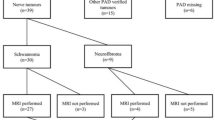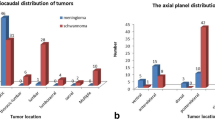Abstract
Objectives
To compare MRI features of sporadic and neurofibromatosis syndrome–related localized schwannomas and neurofibromas.
Methods
In this retrospective study, our pathology database was searched for “neurofibroma” or “schwannoma” from 2014 to 2019. Exclusion criteria were lack of available MRI and intradural or plexiform tumors. Qualitative and quantitative anatomic (location, size, relationship to nerve, signal, muscle denervation) and functional (arterial enhancement, apparent diffusion-weighted coefficient) MRI features of sporadic and syndrome-related tumors were compared. Statistical significance was assumed for p < 0.05.
Results
A total of 80 patients with 64 schwannomas (sporadic: 42 (65.6%) v. syndrome-related: 22 (34.4%)) and 19 neurofibromas (sporadic: 7 (36.8%) v. syndrome-related: 12 (41.7%)) were included. Only signal heterogeneity (T2W p=0.001, post-contrast p=0.03) and a diffused-weighted imaging target sign (p=0.04) were more frequent with schwannomas than neurofibromas. Sporadic schwannomas were similar in size to syndrome-related schwannomas (2.9±1.2cm vs. 3.7±3.2 cm, p = 0.6), but with greater heterogeneity (T2W p = 0.02, post-contrast p = 0.01). Sporadic neurofibromas were larger (4.6±1.5cm vs. 3.4±2.4 cm, p = 0.03) than syndrome-related neurofibromas, also with greater heterogeneity (T2W p=0.03, post-contrast p=0.04). Additional tumors along an affected nerve were only observed with syndrome-related tumors). There was no difference in apparent diffusion coefficient values or presence of early perfusion between sporadic and syndrome-related tumors (p > 0.05).
Conclusions
Although syndrome-related and sporadic schwannomas and neurofibromas overlap in their anatomic, diffusion and perfusion features, signal heterogeneity and presence of multiple lesions along a nerve are differentiating characteristics of syndrome-related tumors.






Similar content being viewed by others
Data Availability
The data that support the findings of this study are available from the corresponding author, P.D., upon reasonable request.
References
Murphey MD, Smith WS, Smith SE, Kransdorf MJ, Temple HT. From the archives of the AFIP. Imaging of musculoskeletal neurogenic tumors: radiologic-pathologic correlation. Radiographics. 1999;19:1253–80.
Kim DH, Murovic JA, Tiel RL, Moes G, Kline DG. A series of 397 peripheral neural sheath tumors: 30-year experience at Louisiana State University Health Sciences Center. J Neurosurg. 2005;102:246–55.
Neurofibroma - an overview | ScienceDirect Topics. [cited 2023 Sep 4]. Available from: https://www.sciencedirect.com/topics/pharmacology-toxicology-and-pharmaceutical-science/neurofibroma. Accessed 4 Sept 2023.
Rodriguez FJ, Folpe AL, Giannini C, Perry A. Pathology of peripheral nerve sheath tumors: diagnostic overview and update on selected diagnostic problems. Acta Neuropathol. 2012;123:295–319.
Zhang M, Tong E, Wong S, Hamrick F, Mohammadzadeh M, Rao V, et al. Machine learning approach to differentiation of peripheral schwannomas and neurofibromas: a multi-center study. Neuro Oncol. 2022;24:601–9.
Caltabiano R, Magro G, Polizzi A, Praticò AD, Ortensi A, D’Orazi V, et al. A mosaic pattern of INI1/SMARCB1 protein expression distinguishes Schwannomatosis and NF2-associated peripheral schwannomas from solitary peripheral schwannomas and NF2-associated vestibular schwannomas. Childs Nerv Syst. 2017;33:933–40.
Plotkin SR, Wick A. Neurofibromatosis and Schwannomatosis. Semin Neurol. 2018;38:73–85.
Ahlawat S, Blakeley JO, Langmead S, Belzberg AJ, Fayad LM. Current status and recommendations for imaging in neurofibromatosis type 1, neurofibromatosis type 2, and schwannomatosis. Skeletal Radiol. 2020;49:199–219.
Belakhoua SM, Rodriguez FJ. Diagnostic pathology of tumors of peripheral nerve. Neurosurgery. 2021;88:443–56.
Ahlawat S, Baig A, Blakeley JO, Jacobs MA, Fayad LM. Multiparametric whole-body anatomic, functional, and metabolic imaging characteristics of peripheral lesions in patients with schwannomatosis. J Magn Reson Imaging. 2016;44:794–803.
Gunasekaran A, Newhart H, Kumar M, Kazemi N. Utility of MRI neurography in neurofibromatosis type I: case example and review of MRI neurography literature. Surg Neurol Int. 2019;10:12.
Salamon J, Veldhoen S, Apostolova I, Bannas P, Yamamura J, Herrmann J, et al. 18F-FDG PET/CT for detection of malignant peripheral nerve sheath tumours in neurofibromatosis type 1: tumour-to-liver ratio is superior to an SUVmax cut-off. Eur Radiol. 2014;24:405–12.
Schwabe M, Spiridonov S, Yanik EL, Jennings JW, Hillen T, Ponisio M, et al. How effective are noninvasive tests for diagnosing malignant peripheral nerve sheath tumors in patients with neurofibromatosis type 1? Diagnosing MPNST in NF1 patients. Sarcoma. 2019;2019:4627521.
Plotkin SR, Blakeley JO, Evans DG, Hanemann CO, Hulsebos TJM, Hunter-Schaedle K, et al. Update from the 2011 International Schwannomatosis Workshop: from genetics to diagnostic criteria. Am J Med Genet A. 2013;0:405–16.
Plotkin SR, Messiaen L, Legius E, Pancza P, Avery RA, Blakeley JO, et al. Updated diagnostic criteria and nomenclature for neurofibromatosis type 2 and schwannomatosis: an international consensus recommendation. Genet Med. 2022;24:1967–77.
Lin J, Martel W. Cross-sectional imaging of peripheral nerve sheath tumors: characteristic signs on CT, MR imaging, and sonography. AJR Am J Roentgenol. 2001;176:75–82.
Lee SK, Kim J-Y, Jeong HS. Benign peripheral nerve sheath tumor of digit versus major-nerve: comparison of MRI findings. PLoS One. 2020;15:e0230816.
Ahlawat S, Fayad LM. Imaging cellularity in benign and malignant peripheral nerve sheath tumors: utility of the “target sign” by diffusion weighted imaging. Eur J Radiol. 2018;102:195–201.
Zipfel J, Al-Hariri M, Gugel I, Grimm A, Steger V, Ladurner R, et al. Surgical management of sporadic peripheral nerve schwannomas in adults: indications and outcome in a single center cohort. Cancers (Basel). 2021;13:1017.
Hilton DA, Hanemann CO. Schwannomas and their pathogenesis. Brain Pathol. 2014;24:205–20.
Debs P, Fayad LM, Ahlawat S. MR neurography of peripheral nerve tumors and tumor-mimics. Semin Roentgenol. 2022;57:232–40.
Ogose A, Hotta T, Morita T, Yamamura S, Hosaka N, Kobayashi H, et al. Tumors of peripheral nerves: correlation of symptoms, clinical signs, imaging features, and histologic diagnosis. Skeletal Radiol. 1999;28:183–8.
Fayad LM, Blakeley J, Plotkin S, Widemann B, Jacobs MA. Whole body MRI at 3T with quantitative diffusion weighted imaging and contrast-enhanced sequences for the characterization of peripheral lesions in patients with neurofibromatosis type 2 and Schwannomatosis. ISRN Radiol. 2013;2013:627932.
Yun JS, Lee MH, Lee SM, Lee JS, Kim HJ, Lee SJ, et al. Peripheral nerve sheath tumor: differentiation of malignant from benign tumors with conventional and diffusion-weighted MRI. Eur Radiol. 2021;31:1548–57.
Li C-S, Huang G-S, Wu H-D, Chen W-T, Shih L-S, Lii J-M, et al. Differentiation of soft tissue benign and malignant peripheral nerve sheath tumors with magnetic resonance imaging. Clin Imaging. 2008;32:121–7.
Soldatos T, Fisher S, Karri S, Ramzi A, Sharma R, Chhabra A. Advanced MR imaging of peripheral nerve sheath tumors including diffusion imaging. Semin Musculoskelet Radiol. 2015;19:179–90.
Bhargava R, Parham DM, Lasater OE, Chari RS, Chen G, Fletcher BD. MR imaging differentiation of benign and malignant peripheral nerve sheath tumors: use of the target sign. Pediatr Radiol. 1997;27:124–9.
Jee W-H, Oh S-N, McCauley T, Ryu K-N, Suh J-S, Lee J-H, et al. Extraaxial neurofibromas versus neurilemmomas: discrimination with MRI. AJR Am J Roentgenol. 2004;183:629–33.
Söderlund V, Göranson H, Bauer HCF. MR imaging of benign peripheral nerve sheath tumors. Acta Radiol. 1994;35:282–6.
Kakkar C, Shetty CM, Koteshwara P, Bajpai S. Telltale signs of peripheral neurogenic tumors on magnetic resonance imaging. Indian J Radiol Imaging. 2015;25:453–8.
Stull MA, Moser RP, Kransdorf MJ, Bogumill GP, Nelson MC. Magnetic resonance appearance of peripheral nerve sheath tumors. Skeletal Radiol. 1991;20:9–14.
Lee SK, Kim J-Y, Lee Y-S, Jeong HS. Intramuscular peripheral nerve sheath tumors: schwannoma, ancient schwannoma, and neurofibroma. Skeletal Radiol. 2020;49:967–75.
Author information
Authors and Affiliations
Corresponding author
Ethics declarations
Conflict of interest
The authors declare no competing interests.
Additional information
Publisher’s Note
Springer Nature remains neutral with regard to jurisdictional claims in published maps and institutional affiliations.
Rights and permissions
Springer Nature or its licensor (e.g. a society or other partner) holds exclusive rights to this article under a publishing agreement with the author(s) or other rightsholder(s); author self-archiving of the accepted manuscript version of this article is solely governed by the terms of such publishing agreement and applicable law.
About this article
Cite this article
Debs, P., Luna, R., Fayad, L.M. et al. MRI features of benign peripheral nerve sheath tumors: how do sporadic and syndromic tumors differ?. Skeletal Radiol 53, 709–723 (2024). https://doi.org/10.1007/s00256-023-04479-1
Received:
Revised:
Accepted:
Published:
Issue Date:
DOI: https://doi.org/10.1007/s00256-023-04479-1




